|
|
|
Sort Order |
|
|
|
Items / Page
|
|
|
|
|
|
|
| Srl | Item |
| 1 |
ID:
133468
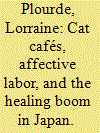

|
|
|
|
|
| Publication |
2014.
|
| Summary/Abstract |
This article examines the Japanese cat café boom, which peaked in 2009 yet remains a significant retail phenomenon throughout Japan, and in particular Tokyo. How do humans encounter animals in contemporary Japan, not as private owners and companions, but as consumers seeking direct, sensory engagement with cats at a moment of profound social and economic anxieties? Drawing on ethnographic fieldwork conducted in Tokyo, this article examines how cats have become a newly emergent commodity within the 'healing boom' that first emerged in recessionary-era 1990s Japan. Such healing commodities - therapeutic music, aromatherapy, robot interaction, among others - are designed to invoke an affective engagement with the consumer in order to cope with the uncertain and stressful conditions of life in still recessionary, and now post 3/11, Japan. I situate cat cafés within the increasing immaterialization of the economy in post-bubble Japan during which social relationships have become commodified and marketed to those who can afford it. Cats are the affective object through which patrons seek a sense of healing and relaxation.
|
|
|
|
|
|
|
|
|
|
|
|
|
|
|
|
| 2 |
ID:
133472
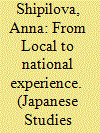

|
|
|
|
|
| Publication |
2014.
|
| Summary/Abstract |
Within Japan, the atomic bombing of Hiroshima is understood as a national experience that sets the country apart from nations that have been spared such devastation. A special phrase the Japanese use to describe their country is yuitsu hibaku kokka, 'the only country that has experienced atomic bombing'. This phrase has become a powerful cliché for depicting Japan to a national and international audience. Even though Hiroshima was the experience of a comparatively small group before it spread to a larger collectivity, its transformation into a collective experience is regarded as a natural outcome, explained by the devastating nature of the event. This perspective, however, does not fully explain why people who have different war experiences unconditionally accept as their own experiences ones which they have not personally suffered. This article aims to clarify the process by which the Hiroshima experience was nationalised, and the period of its nationalisation. It also examines whether this transformation means that Hiroshima has become a 'trauma for everybody'. This is achieved through the application of Jeffrey C. Alexander's work on the transformation of Holocaust memories into a collective trauma.
|
|
|
|
|
|
|
|
|
|
|
|
|
|
|
|
| 3 |
ID:
133471
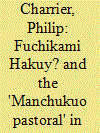

|
|
|
|
|
| Publication |
2014.
|
| Summary/Abstract |
The art photography of Fuchikami Hakuy? and his circle in Japanese Manchuria is commonly and benignly treated as hybridized modernism, a product of the bending of conventional 1930s Japanese styles (pictorialist, constructivist, realist) through contact with the unfamiliar and the exotic. As such it is deemed reflexive in relation to the stimuli of a new land and peoples, but disconnected from the political, economic, and social processes of imperialism and colonialism in Northeast China. The following article uses both structuralist and post-structuralist theoretical approaches to challenge this interpretation, arguing that through the skilful erasure of colonial violence and disruption, the lyrical images of villages, agriculturalists, and factories produced by Fuchikami and his Mansh? Shashin Sakka Ky?kai (Manchuria Photographic Artists Association) participate directly in processes of state construction in Manchukuo. The development of a quasi-documentary pastoral aesthetic by Fuchikami and the Manchuria photographers is given close attention in the analysis, particularly as it relates to the influence of French Barbizon school painting on late nineteenth- and early twentieth-century Japanese art.
|
|
|
|
|
|
|
|
|
|
|
|
|
|
|
|
| 4 |
ID:
133469
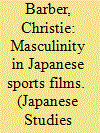

|
|
|
|
|
| Publication |
2014.
|
| Summary/Abstract |
This paper considers three recent Japanese sports films for young people, Feel the Wind (2009), Oppai Volleyball (2009) and Dive!! (2008), which employ a common sports film script to explore the ways in which masculinity is constructed, expressed and evaluated through participation in sport. Through depictions of masculinities that achieve subjective agency and acceptance by peers despite a lack of competence or victory in sport, these films disrupt the established relationship between masculinity, competence and dominance, and endorse non-normative models of masculinity. They also reflect the tensions between a desire for agency, social constraints and expectations, and the dominant ideology of masculinity. In so doing, they help to illuminate the ways in which gender is negotiated in relation to contemporary social and political conditions.
|
|
|
|
|
|
|
|
|
|
|
|
|
|
|
|
| 5 |
ID:
133473
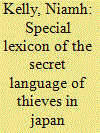

|
|
|
|
|
| Publication |
2014.
|
| Summary/Abstract |
Drawing on a corpus of 300 words, this paper analyses the linguistic characteristics of the special lexicon of the secret language (ingo) used by thieves in Japan between the Edo and Showa periods. A total of 189 words are illustrated to demonstrate how the secret language of thieves can be described in terms of the three strategies used to create this special lexicon: 1) semantic changes introduced into the pre-existing Japanese lexicon; 2) lexical innovations; and 3) morpho-phonological modifications of the pre-existing Japanese lexicon. Strategies used in the creation of the special lexicon are examined in order to determine how the strategies employed in thieves' ingo conform to or deviate from the strategies used in modernising the lexicon of Standard Japanese. This paper also examines how morphological processes utilised in the special lexicon of thieves' secret language interact with Japanese phonology, and concludes that the mora is an indispensable unit for the processes of truncation, hypocoristic formation and reduplication, while the syllable is an indispensable unit for the process of metathesis. Finally, data analysis reveals that truncation and metathesis work at a level which ignores morpheme boundaries, and operate instead at the level of the mora and syllable respectively.
|
|
|
|
|
|
|
|
|
|
|
|
|
|
|
|
| 6 |
ID:
133470


|
|
|
|
|
| Publication |
2014.
|
| Summary/Abstract |
Cultural treatments of the 1995 Tokyo subway gas attacks perpetrated by Aum Supreme Truth (Aum Shinriky?) often reference another tumultuous episode that many argue belongs to the same radical impulse in Japanese society: the violent end to the 'extremist period' of the late 1960s and early 1970s, punctuated by the United Red Army's Asama Sans? incident of 1972. Yet while scholarship and the media have sought to contextualize the gas attacks by directly identifying Aum in relation to United Red Army radicalism, the works examined here thematize the unassimilated nature of the extremist period in the Japanese historical imaginary and complicate the construction of referential ties in the narration of these events. Produced in the years following the attacks, two works of manga serialized in the late 1990s and 2000s - Biriibaazu [Believers, 1999] and Nij?seiki Sh?nen [Twentieth Century Boys, 1999-2006] - represent Aum as a trace of an event that has not been fully assimilated in the cultural consciousness. These two works demonstrate how the largely unclaimed nature of the radical era highlights the problems of transcribing unprocessed events like the United Red Army incident into narrative imaginings of recent Japanese history
|
|
|
|
|
|
|
|
|
|
|
|
|
|
|
|
|
|
|
|
|